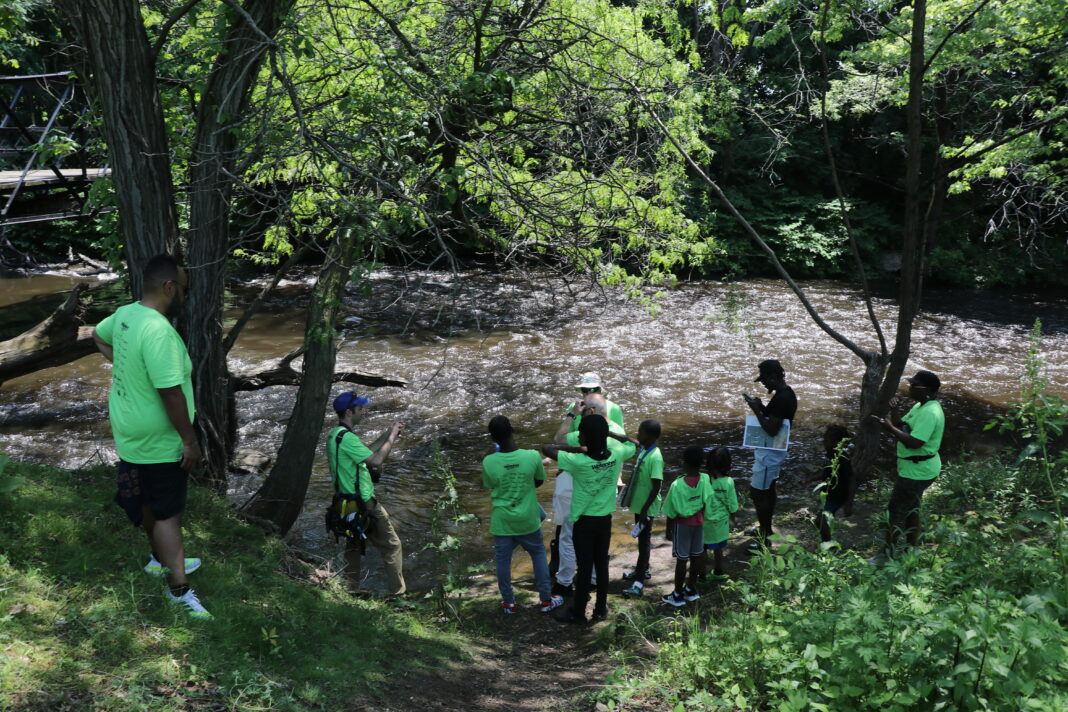The Trenton Community Day and Watershed Cleanup brought people out to George Page Park/Hetzel Field, working with volunteers to clean the Assunpink Creek and teach Trentonians about their woodland neighbors.
Shereyl Snyder, East Trenton Collaborative Community Organizer, helped create the event. “We’ve never collaborated like this before with all these organizations,” Snyder said. “The watershed comes out every year in Mercer County. They do a cleanup.” She explained that they wanted to make it a festival that would become a staple at the beginning of the summer season. “We did the clean up and later we focused on community… Come out for cheers, enjoy the live entertainment and free food.”
Manning the grill was Vincent Bridgett Sr., Executive Director and Founder of Trenton United Family Foundation, better known as TUFF. He was serving up hamburgers, cheeseburgers, and veggie burgers to anyone that came by.
“I was supposed to be a part of the cleanup, you know, but we couldn’t get anybody to get on the grill. So TUFF is out here. Just making a happy mixture to keep everybody happy. So that’s, that’s our contribution right now,” Bridgett said.
There were informational and fun tables run by Artworks Trenton, The Watershed Institute, Urban Promise, Isles, Delaware River Keepers, and Clean Water Action for residents to explore as they listened to music by Show Tyme and Devoura Wise.
“That part is very important, the connection… I mean just collaborating with different individuals. I’m meeting new people. So that’s very important for us,” Bridgett said.
“That’s what brought me to Trenton; community! We got the kids, we got organizations doing the work, and the Trenton Community needs to know these organizations. So here it is, bringing them together. We’re going to where they are instead of them having to go to the org. The org is here, the information is here. I love it,” Snyder said.
That was only half of the project. Before the festivities began, Trenton kids and residents came out to the Assunpink Creek and cleaned up over 200 pounds of trash to keep the stream inhabitable to the wildlife around there.
Olivia Spildooren, the River-Friendly coordinator, explained that this could be the first step for residents to take action to clean their environment.
“I think it is helping about bring awareness about different issues… I think people who live in Trenton already know the issues that they’re facing with water…but I think some people, they want to know solutions or just more about what they can do. So we’re hoping through this they can get connections with different groups that can help them…put something into action,” Spildooren said.
In addition to cleaning, Trenton residents were encouraged to come on a tour to discuss the importance of maintaining the Assunpink Creek. M’Kina Tapscott, Director of Artworks, helped set up the tour with Andrew Loyd, a volunteer at the Trenton Community Day.
“Andrew Lloyd and Shereyl Snider worked together with the watershed Institute in order to develop a storm water tour to show the importance of removing litter from the area…so that the drainage can stay free and help to alleviate flooding issues,” Tapscott said. “It’s really important to make sure that not only you can identify where your stormwater drainage is… but also to keep those spaces clean from litter because if they’re clogged with litter, then they can’t help to alleviate them.”
Loyd explained that they led the tour through the creek showing how it reacts to rising flood rates. “We talked about how the streets in the neighborhoods connect to the river, we talk about floodplains. How floodplains are natural, beautiful things that we shouldn’t really build on, but back in the day, we did.”
A floodplain is an area of land next to a river. The area around the river or stream experiences high amounts of flooding when the river exceeds its boundaries. Loyd explained that building on top of a floodplain can be dangerous to property owners.
“So now we got to take care of people’s property and their livelihood and their lives. So in this case, the answer would be to get the water to the river,” Loyd said.
This happens by a pipeline that takes excess water from the streets in the area and deposits it into the river, bringing trash from the streets and residents.
“We figured we would make that connection and talk about you know, why it’s important not to throw things down the drain because it doesn’t just disappear, it goes to the river,” Loyd said.





